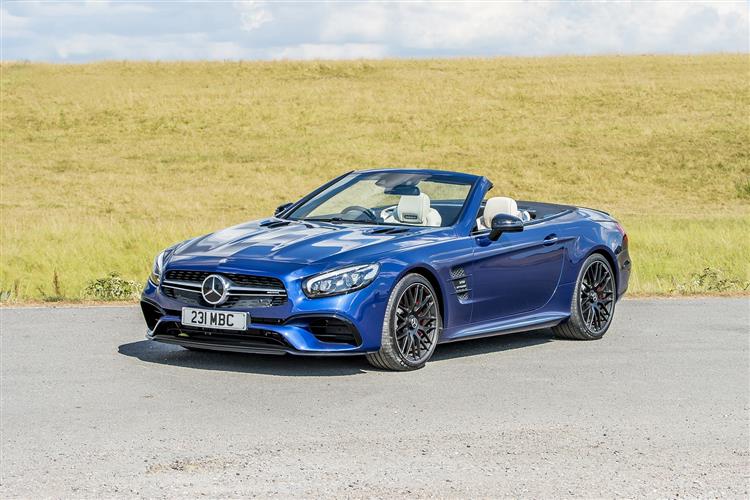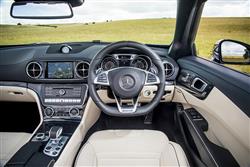SL TO THE POWER OF 63 (some text hidden) --NONE--
By Jonathan Crouch
Introductionword count: 66
The ultimate Mercedes SL 'R231'-series model wasn't the most powerful V12 one. It was this model, the SL 63 AMG, later re-named the Mercedes-AMG SL 63. More than just a very powerful sporting luxury convertible, it aimed to snare supercar buyers too and seemed at launch to have the engine, the looks and the technology to do it. How does it fare as a used buy?
Modelsword count: 5
2dr Cabriolet (4.0, 6.0 petrol]
Historyword count: 322
Can a machine designed first and foremost to be a luxury sports car, if appropriately powered and fettled, really take itself to the next level and transform itself into a fully-fledged six-figure supercar? Back in 2012, the evidence of recent years suggested not. With the arguable exception of Porsche's 911, we found in that period that a more powerful, stiffer, tauter version of a luxury sports car remained exactly that. Desirable, yes, but you wouldn't seriously consider one as a credible alternative to an Aston Martin, a Ferrari or even a Maserati. Even though models from these famous brands wouldn't reel in the horizon any faster than powerful luxury sports car contenders of the period like BMW's M6, Jaguar's XKR-S or indeed, the model we're going to look at here, Mercedes' SL 63 AMG. With this 'R231'-series SL 63 though, Mercedes assured us that things were changing. Prior to its launch in 2012, the success of the SLS AMG gullwing model had proved the Stuttgart brand's supercar credentials beyond doubt and many of the same engineers who created it reckoned that this car was every bit as good, virtually as fast, 35% cheaper to buy and far less expensive to run. They were also adamant about the fact that this model's parentage, based on an 'ordinary' SL, was no disadvantage. After all, the sixth generation version of this iconic model line featured a more dynamic set of underpinnings than any we'd seen in an SL since the Fifties. Matched here to a new twin-turbocharged 5.5-litre V8 engine that not only delivered more power but sounded just as good as anything from Maranello. In 2016, this model got a far-reaching update, at which point it was re-named the Mercedes-AMG SL 63, in line with new Mercedes policy. Production finally finished in 2019, with the last examples sold in early 2020. This car was ultimately replaced by a Mercedes-AMG 'R232'-series model in late 2021.
What You Getword count: 759
This 'R231'-series SL 63 AMG model's more athletic stance is undeniably purposeful. The central feature is a twin-blade grille in high-sheen chrome, with the three-pointed star mounted on two blade-like louvres profiled like an aircraft wing. Below the twin-blade grille, there's a stylised 'A' - a characteristic feature of AMG models - plus a fine black fin at the lower edge of the opening which channels air over the cooling modules. Moving down the side of the car, there are AMG side sill panels and "V8 BITURBO" logos on the vent grilles with fins in silver chrome. At the rear, you'll spy an AMG spoiler lip, four chromed tailpipes for the sports exhaust system and a diffuser-style rear apron with a body-coloured insert. But it's what you can't see that's important here. 'SL' may stand for 'Sport Leicht' but historically, this model has always been something of a sporting heavy hitter, big in bulk and to compensate, well provided for in power. It was a combination hardly in keeping with these eco-conscious times and when early development suggested that despite the engineers' best efforts, this sixth generation 'R231' model would be even lardier, the Stuttgart board took a deep breath and decided to turn the clock back. The very first SL in 1952 was made from aluminium: so too, would be this sixth generation version. That, they knew, would make it expensive for the Bremen factory to build. But a weight saving for this AMG model of up to 170kg would also make it a lot less costly for owners to run. Of course, this car could have been a lot lighter still if the designers had dispensed with the bulky electrically operated Vario metal folding roof that by 2012, only Mercedes was still providing in this segment. It eats into boot space and makes it impossible for this car to offer the pair of occasional rear seats you'll find in competitors from Jaguar, BMW and Porsche but it's also one of the things that most appeals about this car to city-based buyers. The mechanism is still slower than a fabric hood would be and, unlike a rag top, has the disadvantage that it can't be operated at slow speeds on the move. However, it was speeded up with this generation model to raise or lower the elaborate metal panels in a respectably rapid 20 seconds. Of course, in our miserable climate, you'll be travelling top-up rather a lot of the time but at least when you are, there'll be more of a light and airy feeling if you get yourself a car whose original owner ticked the box to specify the roof either in panoramic glass form with a draw-across blind or with what Mercedes calls 'MAGIC SKY CONTROL'. It's a neat touch that uses electro-reactive particles to switch the roof panel from light to dark at the press of a button. Which means that roof-up motoring can be a little more pleasant. Roof-down progress can also be more comfortable if you get a car whose original owner specified the neat AIRSCARF neck-level heating system that'll make you more tempted to travel alfresco on chilly mornings Some things didn't change here though. In period, this remained the most spacious car in its class for front seat occupants, thanks to the fact that this current generation model grew by 50mm in length and 57mm in width. The result is the most un-sportscar-like feeling of being able to spread out a little within the beautifully-finished cabin. For the cabin, influences were drawn from the world of aviation, with gorgeous jet-turbine-style air vents dominating a wing-shaped dash with a centre console modelled on the flight deck of an aircraft. Buyers of this top sporting model get AMG sports seats in single tone or two-tone Nappa leather, AMG carbonfibre trim, AMG illuminated door sill panels, an AMG performance steering wheel with logo in the lower metal insert, AMG instruments with a TFT colour monitor and an AMG start-up display with RACETIMER mode. To your left, the dash is dominated by the huge COMMAND infotainment display screen the controller for which is down near the small but exquisitely-styled DIRECT SELECT gearshift lever. The only change we wouldn't have made over the previous design was the addition of an electrically-operated parking brake. Still, that freed up more cabin storage space. Talking of which, the fact that there's only room for two people inside does at least free up room for a lockable box behind the passenger seat for keeping valuables away from prying eyes.
To see the full road test text contact us on 0330 0020 227
Pictures (high res disabled)

.jpg)
|
.jpg)
|
.jpg)
| |||
.jpg)
|
.jpg)
|
.jpg)
| |||
.jpg)
|
.jpg)
|
.jpg)
| |||

|
Scoring (subset of scores)
Category: Convertibles
| Performance | |
| Handling | |
| Comfort | |
| Space | |
| Styling, Build, Value, Equipment, Depreciation, Handling, Insurance and Total scores are available with our full data feed. | |



